Cyber Security: An In-depth Review of Evidence and Implications
VerifiedAdded on 2023/06/13
|5
|1329
|138
Literature Review
AI Summary
This literature review delves into the realm of cyber security, focusing on cyber-dependent crimes such as hacking and malware injection attacks. It examines various vulnerabilities like viruses, worms, and Trojans, alongside hacking methods like spam and botnets. The review synthesizes findings from surveys and research, highlighting the prevalence of negative internet experiences and malware attacks over the past decade. It also addresses the challenges in reporting cybercrimes to the police, including lack of understanding and insufficient evidence. While the paper effectively presents evidence of ongoing cybercrimes, it lacks a comprehensive discussion of solutions, prompting further consideration of preventative measures. Desklib provides access to a wide array of solved assignments and study tools to assist students in their academic endeavors.
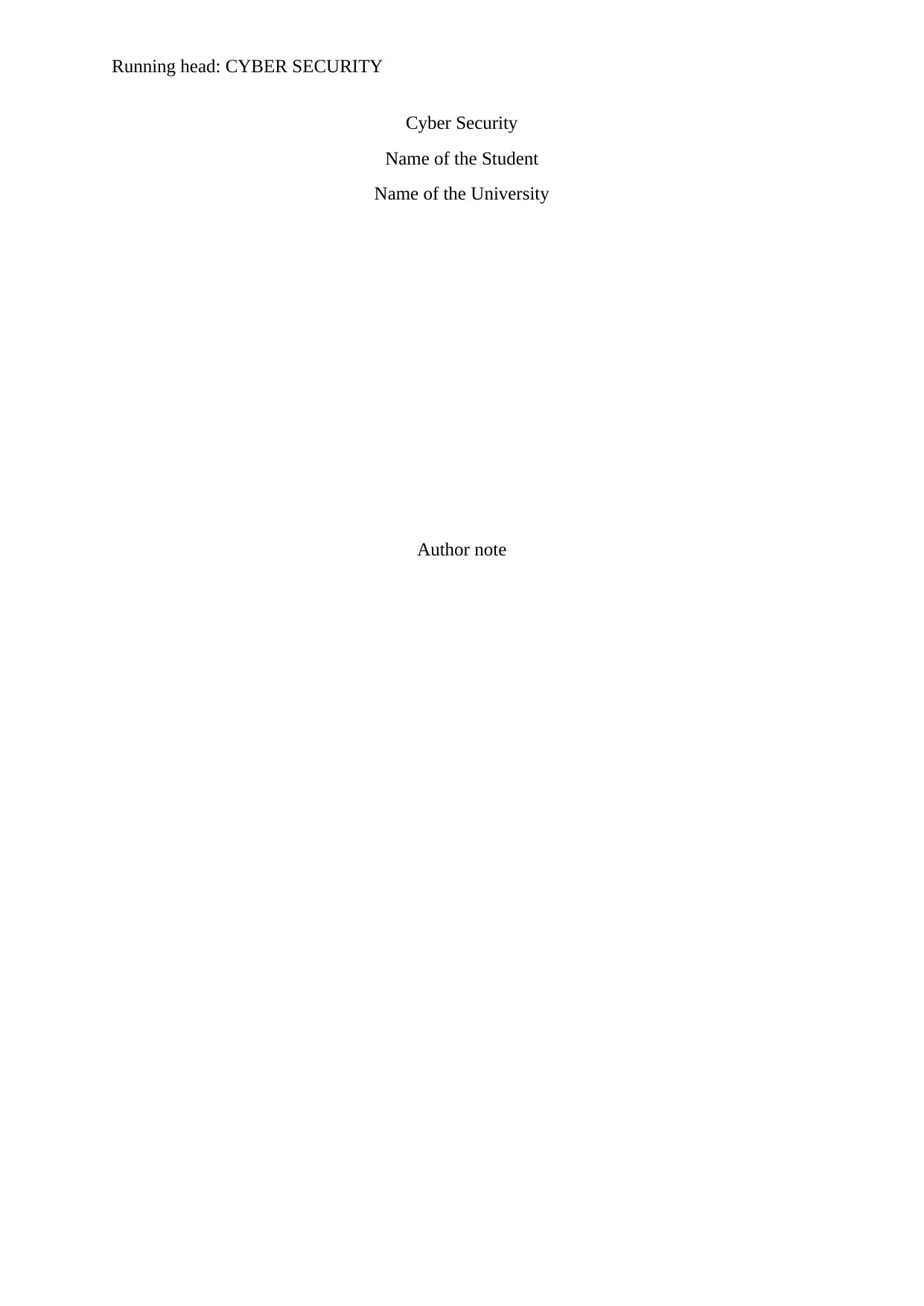
Running head: CYBER SECURITY
Cyber Security
Name of the Student
Name of the University
Author note
Cyber Security
Name of the Student
Name of the University
Author note
Paraphrase This Document
Need a fresh take? Get an instant paraphrase of this document with our AI Paraphraser
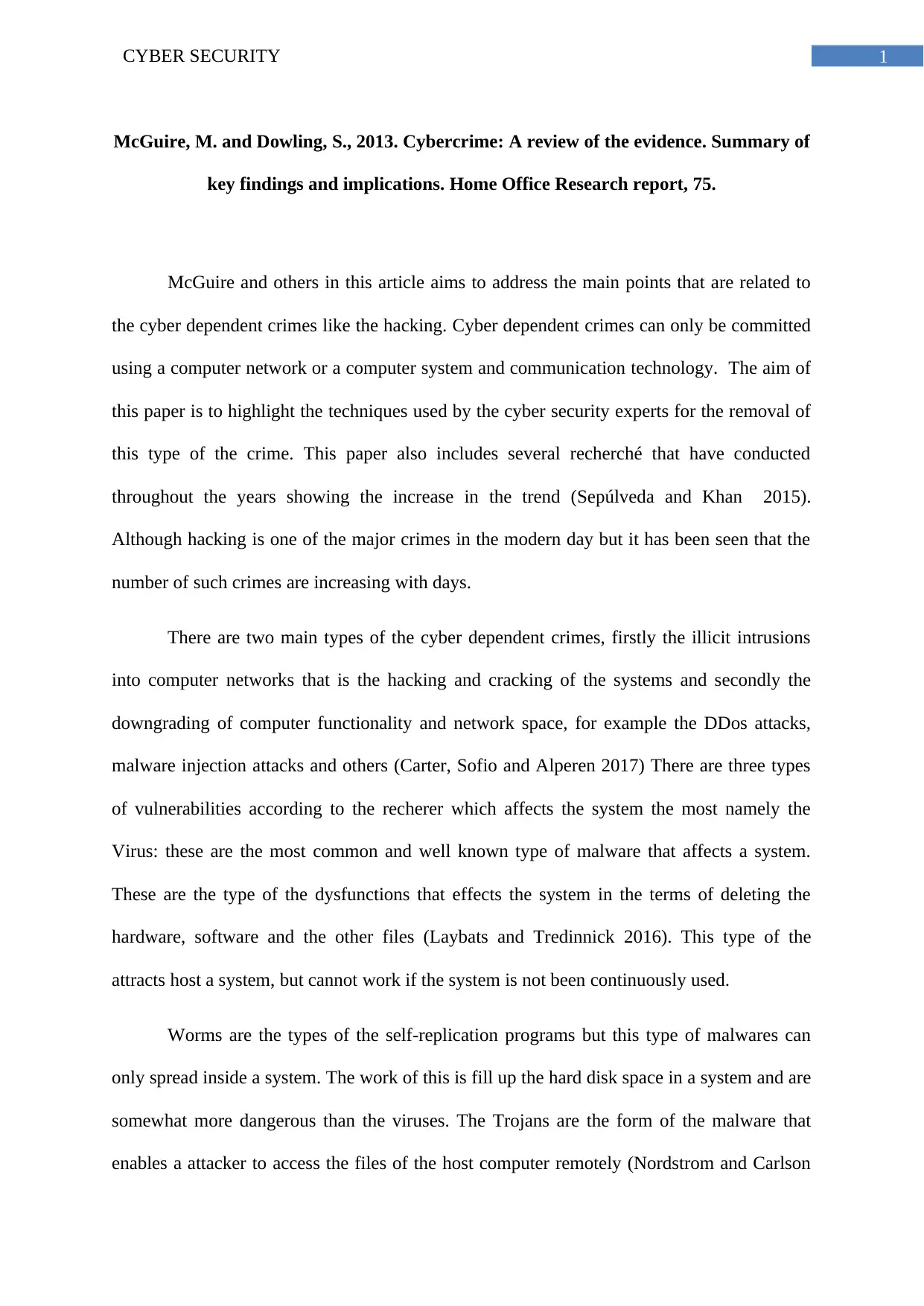
1CYBER SECURITY
McGuire, M. and Dowling, S., 2013. Cybercrime: A review of the evidence. Summary of
key findings and implications. Home Office Research report, 75.
McGuire and others in this article aims to address the main points that are related to
the cyber dependent crimes like the hacking. Cyber dependent crimes can only be committed
using a computer network or a computer system and communication technology. The aim of
this paper is to highlight the techniques used by the cyber security experts for the removal of
this type of the crime. This paper also includes several recherché that have conducted
throughout the years showing the increase in the trend (Sepúlveda and Khan 2015).
Although hacking is one of the major crimes in the modern day but it has been seen that the
number of such crimes are increasing with days.
There are two main types of the cyber dependent crimes, firstly the illicit intrusions
into computer networks that is the hacking and cracking of the systems and secondly the
downgrading of computer functionality and network space, for example the DDos attacks,
malware injection attacks and others (Carter, Sofio and Alperen 2017) There are three types
of vulnerabilities according to the recherer which affects the system the most namely the
Virus: these are the most common and well known type of malware that affects a system.
These are the type of the dysfunctions that effects the system in the terms of deleting the
hardware, software and the other files (Laybats and Tredinnick 2016). This type of the
attracts host a system, but cannot work if the system is not been continuously used.
Worms are the types of the self-replication programs but this type of malwares can
only spread inside a system. The work of this is fill up the hard disk space in a system and are
somewhat more dangerous than the viruses. The Trojans are the form of the malware that
enables a attacker to access the files of the host computer remotely (Nordstrom and Carlson
McGuire, M. and Dowling, S., 2013. Cybercrime: A review of the evidence. Summary of
key findings and implications. Home Office Research report, 75.
McGuire and others in this article aims to address the main points that are related to
the cyber dependent crimes like the hacking. Cyber dependent crimes can only be committed
using a computer network or a computer system and communication technology. The aim of
this paper is to highlight the techniques used by the cyber security experts for the removal of
this type of the crime. This paper also includes several recherché that have conducted
throughout the years showing the increase in the trend (Sepúlveda and Khan 2015).
Although hacking is one of the major crimes in the modern day but it has been seen that the
number of such crimes are increasing with days.
There are two main types of the cyber dependent crimes, firstly the illicit intrusions
into computer networks that is the hacking and cracking of the systems and secondly the
downgrading of computer functionality and network space, for example the DDos attacks,
malware injection attacks and others (Carter, Sofio and Alperen 2017) There are three types
of vulnerabilities according to the recherer which affects the system the most namely the
Virus: these are the most common and well known type of malware that affects a system.
These are the type of the dysfunctions that effects the system in the terms of deleting the
hardware, software and the other files (Laybats and Tredinnick 2016). This type of the
attracts host a system, but cannot work if the system is not been continuously used.
Worms are the types of the self-replication programs but this type of malwares can
only spread inside a system. The work of this is fill up the hard disk space in a system and are
somewhat more dangerous than the viruses. The Trojans are the form of the malware that
enables a attacker to access the files of the host computer remotely (Nordstrom and Carlson
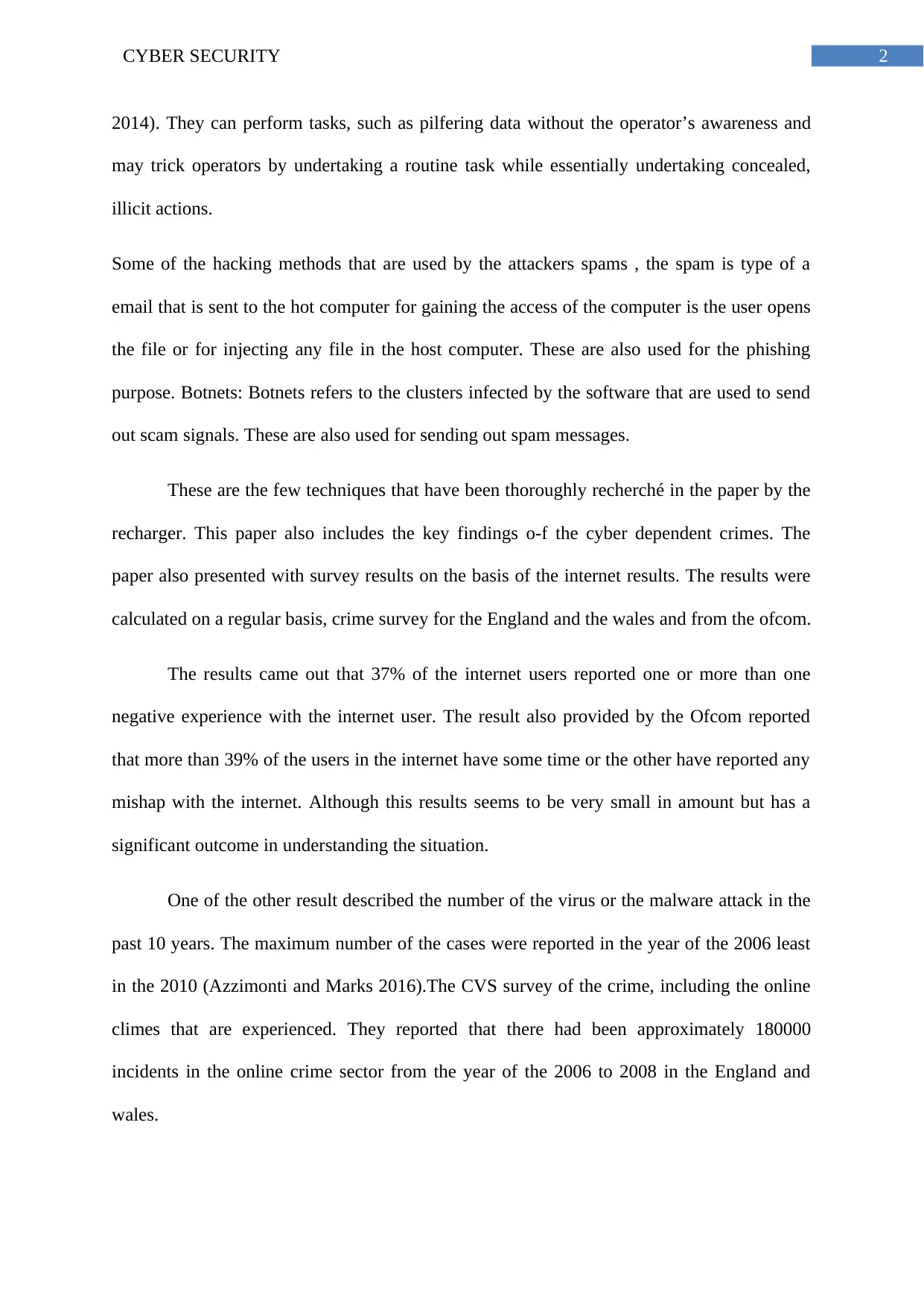
2CYBER SECURITY
2014). They can perform tasks, such as pilfering data without the operator’s awareness and
may trick operators by undertaking a routine task while essentially undertaking concealed,
illicit actions.
Some of the hacking methods that are used by the attackers spams , the spam is type of a
email that is sent to the hot computer for gaining the access of the computer is the user opens
the file or for injecting any file in the host computer. These are also used for the phishing
purpose. Botnets: Botnets refers to the clusters infected by the software that are used to send
out scam signals. These are also used for sending out spam messages.
These are the few techniques that have been thoroughly recherché in the paper by the
recharger. This paper also includes the key findings o-f the cyber dependent crimes. The
paper also presented with survey results on the basis of the internet results. The results were
calculated on a regular basis, crime survey for the England and the wales and from the ofcom.
The results came out that 37% of the internet users reported one or more than one
negative experience with the internet user. The result also provided by the Ofcom reported
that more than 39% of the users in the internet have some time or the other have reported any
mishap with the internet. Although this results seems to be very small in amount but has a
significant outcome in understanding the situation.
One of the other result described the number of the virus or the malware attack in the
past 10 years. The maximum number of the cases were reported in the year of the 2006 least
in the 2010 (Azzimonti and Marks 2016).The CVS survey of the crime, including the online
climes that are experienced. They reported that there had been approximately 180000
incidents in the online crime sector from the year of the 2006 to 2008 in the England and
wales.
2014). They can perform tasks, such as pilfering data without the operator’s awareness and
may trick operators by undertaking a routine task while essentially undertaking concealed,
illicit actions.
Some of the hacking methods that are used by the attackers spams , the spam is type of a
email that is sent to the hot computer for gaining the access of the computer is the user opens
the file or for injecting any file in the host computer. These are also used for the phishing
purpose. Botnets: Botnets refers to the clusters infected by the software that are used to send
out scam signals. These are also used for sending out spam messages.
These are the few techniques that have been thoroughly recherché in the paper by the
recharger. This paper also includes the key findings o-f the cyber dependent crimes. The
paper also presented with survey results on the basis of the internet results. The results were
calculated on a regular basis, crime survey for the England and the wales and from the ofcom.
The results came out that 37% of the internet users reported one or more than one
negative experience with the internet user. The result also provided by the Ofcom reported
that more than 39% of the users in the internet have some time or the other have reported any
mishap with the internet. Although this results seems to be very small in amount but has a
significant outcome in understanding the situation.
One of the other result described the number of the virus or the malware attack in the
past 10 years. The maximum number of the cases were reported in the year of the 2006 least
in the 2010 (Azzimonti and Marks 2016).The CVS survey of the crime, including the online
climes that are experienced. They reported that there had been approximately 180000
incidents in the online crime sector from the year of the 2006 to 2008 in the England and
wales.
⊘ This is a preview!⊘
Do you want full access?
Subscribe today to unlock all pages.

Trusted by 1+ million students worldwide
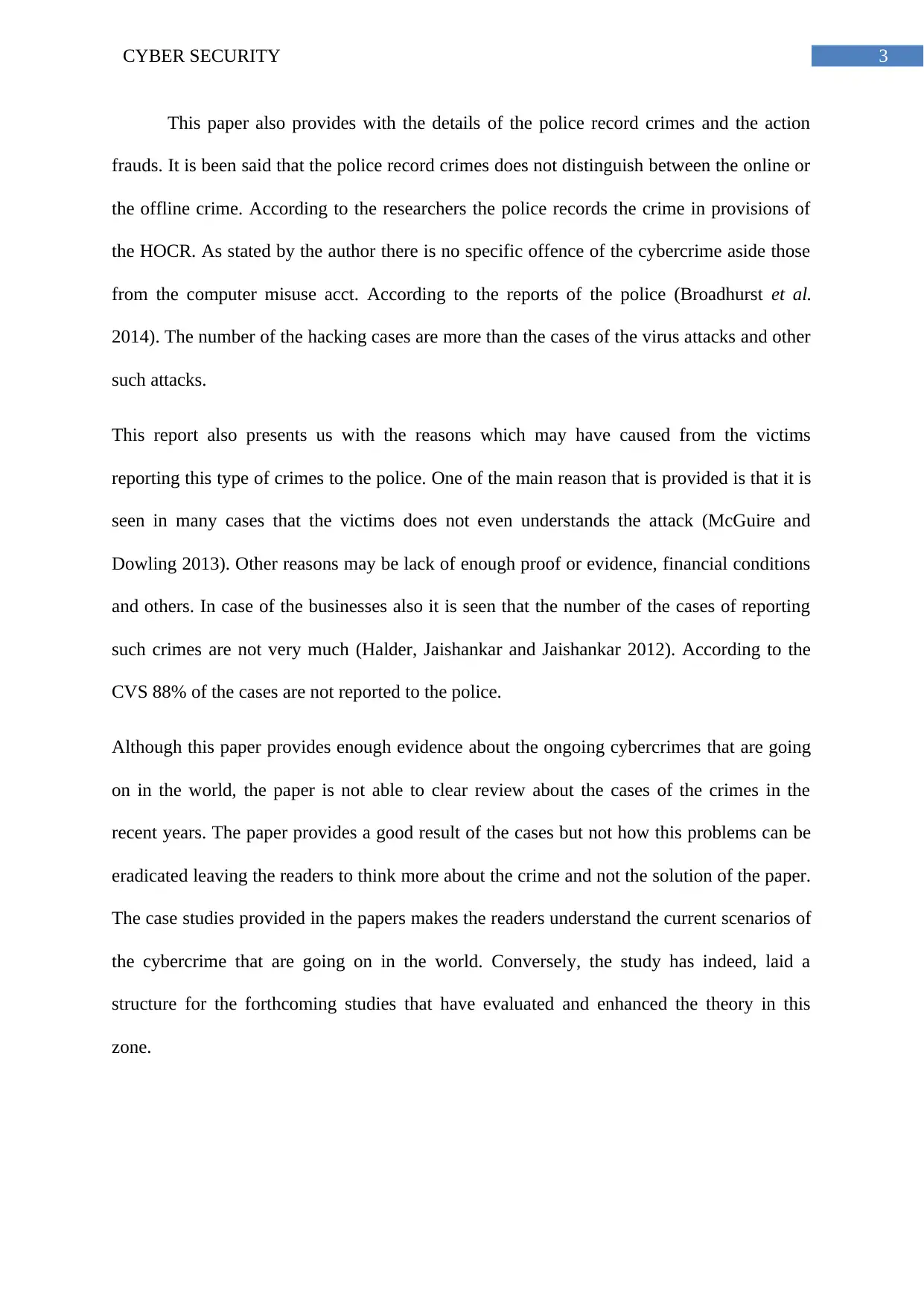
3CYBER SECURITY
This paper also provides with the details of the police record crimes and the action
frauds. It is been said that the police record crimes does not distinguish between the online or
the offline crime. According to the researchers the police records the crime in provisions of
the HOCR. As stated by the author there is no specific offence of the cybercrime aside those
from the computer misuse acct. According to the reports of the police (Broadhurst et al.
2014). The number of the hacking cases are more than the cases of the virus attacks and other
such attacks.
This report also presents us with the reasons which may have caused from the victims
reporting this type of crimes to the police. One of the main reason that is provided is that it is
seen in many cases that the victims does not even understands the attack (McGuire and
Dowling 2013). Other reasons may be lack of enough proof or evidence, financial conditions
and others. In case of the businesses also it is seen that the number of the cases of reporting
such crimes are not very much (Halder, Jaishankar and Jaishankar 2012). According to the
CVS 88% of the cases are not reported to the police.
Although this paper provides enough evidence about the ongoing cybercrimes that are going
on in the world, the paper is not able to clear review about the cases of the crimes in the
recent years. The paper provides a good result of the cases but not how this problems can be
eradicated leaving the readers to think more about the crime and not the solution of the paper.
The case studies provided in the papers makes the readers understand the current scenarios of
the cybercrime that are going on in the world. Conversely, the study has indeed, laid a
structure for the forthcoming studies that have evaluated and enhanced the theory in this
zone.
This paper also provides with the details of the police record crimes and the action
frauds. It is been said that the police record crimes does not distinguish between the online or
the offline crime. According to the researchers the police records the crime in provisions of
the HOCR. As stated by the author there is no specific offence of the cybercrime aside those
from the computer misuse acct. According to the reports of the police (Broadhurst et al.
2014). The number of the hacking cases are more than the cases of the virus attacks and other
such attacks.
This report also presents us with the reasons which may have caused from the victims
reporting this type of crimes to the police. One of the main reason that is provided is that it is
seen in many cases that the victims does not even understands the attack (McGuire and
Dowling 2013). Other reasons may be lack of enough proof or evidence, financial conditions
and others. In case of the businesses also it is seen that the number of the cases of reporting
such crimes are not very much (Halder, Jaishankar and Jaishankar 2012). According to the
CVS 88% of the cases are not reported to the police.
Although this paper provides enough evidence about the ongoing cybercrimes that are going
on in the world, the paper is not able to clear review about the cases of the crimes in the
recent years. The paper provides a good result of the cases but not how this problems can be
eradicated leaving the readers to think more about the crime and not the solution of the paper.
The case studies provided in the papers makes the readers understand the current scenarios of
the cybercrime that are going on in the world. Conversely, the study has indeed, laid a
structure for the forthcoming studies that have evaluated and enhanced the theory in this
zone.
Paraphrase This Document
Need a fresh take? Get an instant paraphrase of this document with our AI Paraphraser
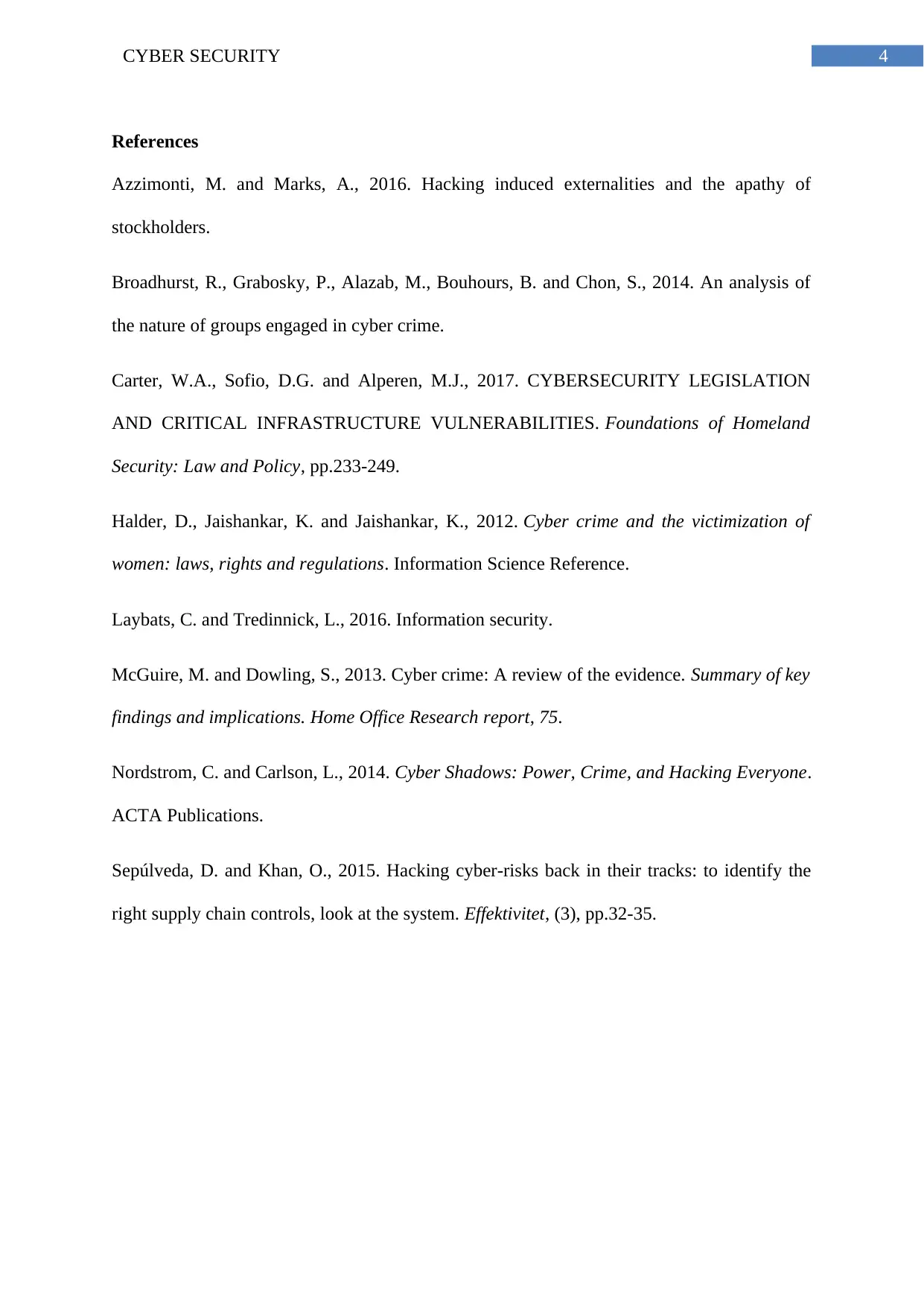
4CYBER SECURITY
References
Azzimonti, M. and Marks, A., 2016. Hacking induced externalities and the apathy of
stockholders.
Broadhurst, R., Grabosky, P., Alazab, M., Bouhours, B. and Chon, S., 2014. An analysis of
the nature of groups engaged in cyber crime.
Carter, W.A., Sofio, D.G. and Alperen, M.J., 2017. CYBERSECURITY LEGISLATION
AND CRITICAL INFRASTRUCTURE VULNERABILITIES. Foundations of Homeland
Security: Law and Policy, pp.233-249.
Halder, D., Jaishankar, K. and Jaishankar, K., 2012. Cyber crime and the victimization of
women: laws, rights and regulations. Information Science Reference.
Laybats, C. and Tredinnick, L., 2016. Information security.
McGuire, M. and Dowling, S., 2013. Cyber crime: A review of the evidence. Summary of key
findings and implications. Home Office Research report, 75.
Nordstrom, C. and Carlson, L., 2014. Cyber Shadows: Power, Crime, and Hacking Everyone.
ACTA Publications.
Sepúlveda, D. and Khan, O., 2015. Hacking cyber-risks back in their tracks: to identify the
right supply chain controls, look at the system. Effektivitet, (3), pp.32-35.
References
Azzimonti, M. and Marks, A., 2016. Hacking induced externalities and the apathy of
stockholders.
Broadhurst, R., Grabosky, P., Alazab, M., Bouhours, B. and Chon, S., 2014. An analysis of
the nature of groups engaged in cyber crime.
Carter, W.A., Sofio, D.G. and Alperen, M.J., 2017. CYBERSECURITY LEGISLATION
AND CRITICAL INFRASTRUCTURE VULNERABILITIES. Foundations of Homeland
Security: Law and Policy, pp.233-249.
Halder, D., Jaishankar, K. and Jaishankar, K., 2012. Cyber crime and the victimization of
women: laws, rights and regulations. Information Science Reference.
Laybats, C. and Tredinnick, L., 2016. Information security.
McGuire, M. and Dowling, S., 2013. Cyber crime: A review of the evidence. Summary of key
findings and implications. Home Office Research report, 75.
Nordstrom, C. and Carlson, L., 2014. Cyber Shadows: Power, Crime, and Hacking Everyone.
ACTA Publications.
Sepúlveda, D. and Khan, O., 2015. Hacking cyber-risks back in their tracks: to identify the
right supply chain controls, look at the system. Effektivitet, (3), pp.32-35.
1 out of 5
Related Documents
Your All-in-One AI-Powered Toolkit for Academic Success.
+13062052269
info@desklib.com
Available 24*7 on WhatsApp / Email
![[object Object]](/_next/static/media/star-bottom.7253800d.svg)
Unlock your academic potential
Copyright © 2020–2025 A2Z Services. All Rights Reserved. Developed and managed by ZUCOL.





